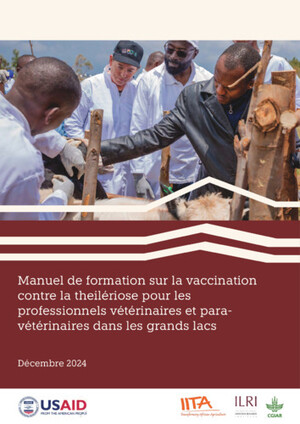
Development of new diagnostic assays and epidemiological surveillance of viral pathogens of livestock in Africa
Sensitive and specific diagnostic tests to discriminate livestock pathogens are essential for disease surveillance and to support cost effective and targeted deployment of control measures. Such diagnostic tools enable collection of data for input to impact assessment and modelling of health constraints to livestock production and both regional and International trade. The project seeks to build on the initial successful collaboration between CISA-INIA and ILRI on three viral diseases, African Swine Fever (ASF), Rift valley Fever (RVF) and Lumpy skin disease (LSD) that are important in constraining trade in Africa. The major focus will remain ASF (for which CISA-INIA is an OIE and EU reference centre). This is due both to the growing importance of the swine sector in sub-Saharan Africa and the threat posed both regionally and globally to trade in pigs and pig products. There will be additional work on Rift Valley Fever (RVF) and LSD. In phase 1 of the project, the expertise of CISA has been applied to initiating development of improved antigen-specific serological tests for ASF use in East Africa, determining viral prevalence in the region and analysing molecular epidemiology using nucleic acid based methods. An experimental ELISA antibody detection ELISA has been developed for RVF detection. It is planned that work will also begin on LSD in 2007-2008. In phase 2 the project will build on the initial work to develop improved diagnostic assays for use in Africa and put increased emphasis on technology transfer and capacity building within the region.
Objectives/goals
General objectives:
To improve the control of viral diseases of livestock in Africa focussed on ASF, RVF and LSD (Capripoxes).
This will be achieved through utilising diagnostic assays to obtain data on the impact of three major viral diseases of livestock in relation the livelihoods of the poor in Africa and assess threats to human health (RVF) and constraints to increased trade and livestock production posed by these diseases.
To implement the required technology transfer in order to strengthen the indigenous capacity in Africa.
The activities within the project on training for ASF diagnosis within East Africa will be extended following the successful training course held in partnership with the Department of Veterinary Services, Kenya to Uganda and subsequently Tanzania. The training activities will also be extended to Nigeria (West Africa). In addition to extending the geographical scope of training PCR diagnosis will also be included.
In addition to diagnostic training courses a post-graduate fellow from Nairobi University will contribute directly to the research component of the project by working for several months in each year of the project at the Valdeolmos laboratory, thereby strengthening indigenous research capacity in the region.
To improve and apply the existing diagnostic assays for the three chosen prioritised diseases ASF, RVF, LSD.
In particular the project will validate improved antibody-specific ELISA tests for ASF developed in phase 1, using field sera from Africa and also develop a real time PCR assay for ASF to quantify viral loads. The project will also use sera from indigenous regions to validate antigen-specific ELISA tests for RVF as well as molecular qPCR based tests. The recent outbreak of RVF in Kenya re-emphasises the importance of this disease in East Africa. Application of the CISA-INIA nucleic acid-based test for LSD will allow initial surveillance in East Africa.
Project location
Kenya, Uganda, Tanzania, Nigeria, Spain
Partnerships
Work towards the development of improved diagnostic tests and evaluation of viral prevalence and molecular diversity for African Swine Fever and Rift Valley Fever in East and Central Africa by the National Institute for Agriculture and Food Research and Technology of Spain (INIA) and involves collaboration with the viral diagnostics unit CISA-INIA at Valdeolmos, Madrid. CISA are providing staff expertise, intellectual input, diagnostic reagents and utilisation of their BSL 3 laboratory for viral culture and in vivo infections of swine and experimental animals. Validation and registration of the test will be carried out in partnership with the Department of Veterinary Services and the Kenya Medical Research Institute. These organizations are making available both facilities and material from recent outbreaks of these diseases in Kenya.
Expected outputs
- Improved capacity for detection and control of African swine fever in East Africa and West Africa through supply of ELISA kits and PCR primers and training in their use.
- A database cataloguing ASFV isolates from indigenous pigs and warthog-associated ticks in East Africa that will provide insight into the epidemiology of the diseases, including the role of the sylvatic involving ticks and wildlife and also genetically resistant domestic swine in disease transmission.
- Data on the role of the wildlife reservoir in bushpigs and warthogs in the epidemiology of ASF in Kenya
- Application of sero-diagnostic tests and detection of asymptomatic carrier animals using sensitive DNA-based tests to provide improved surveillance and pathogen characterisation in regions where outbreaks have occurred
- Evaluation of viral genetic polymorphisms in the maintenance of asymptomatic carrier animals that pose a threat to re-stocking of affected areas with unaffected animals
- An experimental antigen-specific ELISA for Rift Valley fever detection which will help to define the prevalence and importance of the disease
- A real time qPCR assay for the detection of RVFV to monitor the presence of circulating virus.
- Data on prevalence of lumpy skin disease in cattle in East Africa.
- A PhD thesis on the molecular diversity of the ASF virus in Eastern Africa

















